MIST
Magnetosphere, Ionosphere and Solar-Terrestrial
Nuggets of MIST science, summarising recent papers from the UK MIST community in a bitesize format.
If you would like to submit a nugget, please fill in the following form: https://forms.gle/Pn3mL73kHLn4VEZ66 and we will arrange a slot for you in the schedule. Nuggets should be 100–300 words long and include a figure/animation. Please get in touch!
If you have any issues with the form, please contact This email address is being protected from spambots. You need JavaScript enabled to view it..
Extreme Event Statistics in Dst, SYM-H, and SMR Geomagnetic Indices
Aisling Bergin (University of Warwick)
Extreme space weather events are rare, and quantifying their likelihood relies upon long-term continuous observations. High-quality ground-based magnetometer observations underpin geomagnetic indices that monitor space weather and span multiple solar cycles. The Dst index ring-current monitor, derived from an hourly average over four low-latitude stations, is a benchmark for extreme space weather events, and has been extensively studied statistically. Space weather storms cause magnetic perturbation that can be localized in space and time. Geomagnetic ring current indices are available which use a larger number of magnetometers than Dst: SYM-H (derived from 6 stations) and SuperMAG SMR (derived from up to 120 stations).
In this paper we perform the first extreme value theory (EVT) analysis of SYM-H and SMR. EVT analysis reveals a divergence between the return level found for Dst, and those for SYM-H and SMR, that increases non-linearly with return period. For return periods below 10 years, hourly averaged SYM-H and SMR have return levels similar to Dst, but at return periods of 50 and 100 years, they respectively exceed that of Dst by about 10% and 15% (SYM-H) and about 7% and 12% (SMR). One minute resolution SYM-H and SMR return levels progressively exceed that of Dst; their 5, 10, 50, and 100 year return levels exceed that of Dst by about 10%, 12%, 20% and 25% respectively. Our results indicate that consideration should be given to the differences between the indices if selecting one to use as a benchmark in model validation or resilience planning for the wide range of space weather sensitive systems that underpin our society.
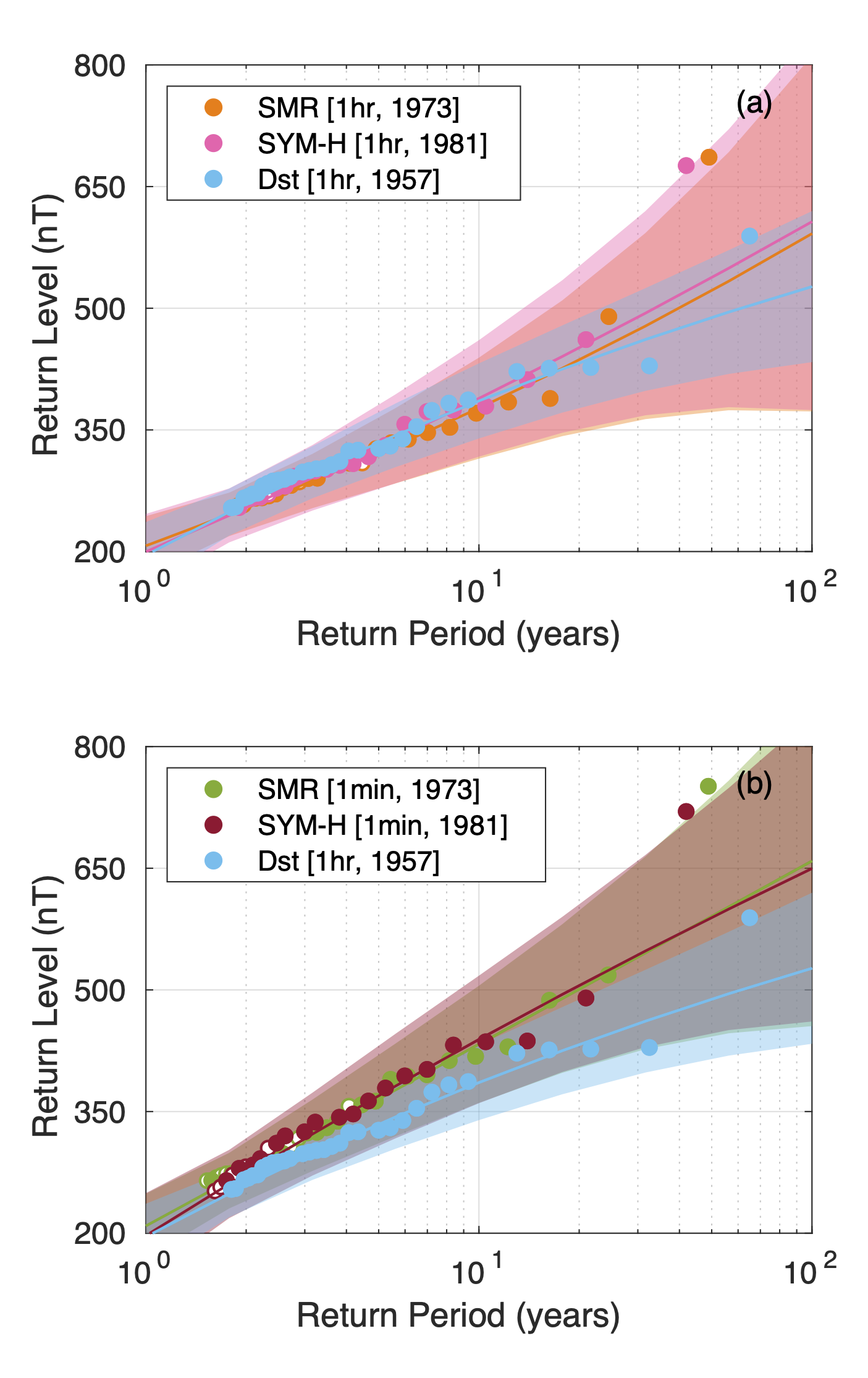
Please see the paper for full details: Bergin, A., Chapman, S. C., Watkins, N. W., Moloney, N. R., & Gjerloev, J. W. (2023). Extreme event statistics in Dst, SYM-H, and SMR geomagnetic indices. Space Weather, 21, e2022SW003304. https://doi.org/10.1029/2022SW003304
The predictive power of magnetospheric models for estimating ground magnetic field variation in the United Kingdom
Ewelina Florczak (British Geological Survey, University of Edinburgh)
Space weather events can have damaging effects on ground-based infrastructure. Geomagnetically induced currents caused by rapid magnetic field fluctuations during geomagnetic storms can negatively affect power networks, railways as well as navigation systems. To reduce such negative impacts, good forecasting capability is essential. In this study we assess the performance of contemporary magnetohydrodynamic (MHD) models in predicting the ground magnetic field perturbations at three UK observatories during two severe space weather events: September 2017 and March 2015. Simulated magnetic data were acquired via Community Coordinated Modeling Center1, using the following models: Space Weather Modeling Framework (SWMF), Open Geospace General Circulation Model (Open GGCM) and Lyon–Fedder–Mobarry (LFM) combined with the Rice Convection Model (RCM). Qualitative and quantitative comparison between measured and modelled values suggest that the performance of MHD models vary with latitude, the magnetic component and the characteristics of the storm analysed. Most models tend to exaggerate the magnitude of disturbances at lower latitudes but better capture the fluctuations at the highest latitude. For the two storms investigated, the addition of RCM tends to result in overestimation of the amplitude of ground perturbations. The observed data-model discrepancies most likely arise due to the many approximations required in MHD modelling, such as simplified solar wind input or shift in location of the electrojets in the simulated magnetospheric and ionospheric currents. It was found that no model performs consistently better than any other, implying that each simulation forecasts different aspects of ground perturbations with varying level of accuracy. Ultimately, the decision of which model is most suitable depends on specific needs of the potential end user.
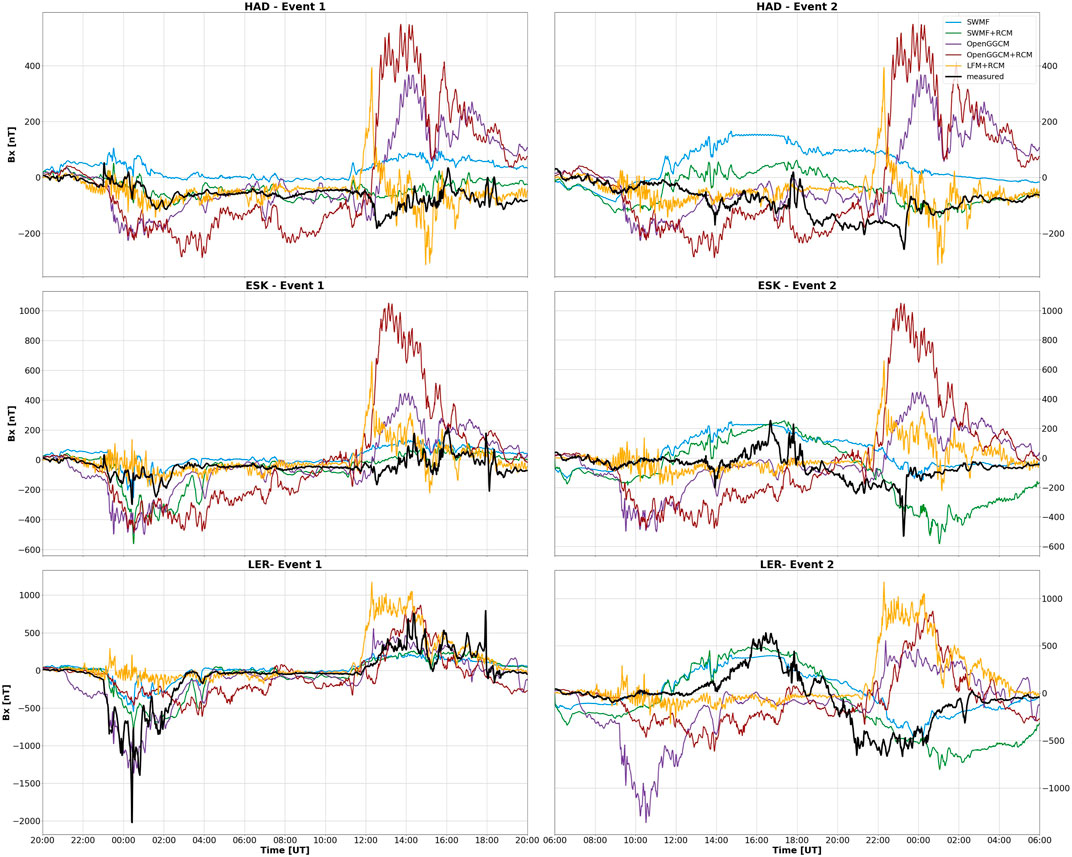
References:
For further details see Florczak E, Beggan CD and Whaler KA (2023) The predictive power of magnetospheric models for estimating ground magnetic field variation in the United Kingdom. Front. Astron. Space Sci. 10:1095971. doi: 10.3389/fspas.2023.1095971
Revealing the process behind the limitation of electron fluxes in the heart of the outer radiation belt
Suman Chakraborty (Northumbria University)
The dynamics of the Earth’s outer radiation belts is highly complex arising from a delicate competition between different physical processes including acceleration, transport, and loss. During periods of enhanced geomagnetic activities, the outer radiation belt electron fluxes may vary by several orders of magnitude which can result in severe spacecraft damage, and in some extreme cases, may even lead to spacecraft failure. Therefore, understanding the processes that are responsible for the observed radiation belt variability remains an active topic of research. In this paper (see below for details), we provide direct observational evidence of the process that results in the limitation of outer radiation belt electron fluxes during geomagnetic storms. To conduct this study, we used electromagnetic wave and electron flux measurements from the Van Allen Probes during 70 isolated geomagnetic storms spanning the entire mission (2012 – 2019). We found that during the main phase of geomagnetic storms, when the flux of tens of keV electrons reaches close to or exceeds a theoretically predicted limiting flux value, intense chorus waves are generated having wave power 2 – 3 orders of magnitude larger than the pre-storm level. These intense chorus waves (wave power > 10-4 nT2, a value chosen from the superposed epoch response of the storms) rapidly scatter electrons into the loss cone causing atmospheric precipitation, thereby maintaining the fluxes at a value close to the limit predicted by Kennel and Petschek more than 50 years ago (see Figure 1). This study provides a significant advance in our understanding of the radiation belt variability as it shows that the electron fluxes cannot grow uncontrollably during geomagnetic storms, instead, they are capped through a chorus wave-driven flux-limitation process that is independent of the acceleration mechanism or source responsible for the flux enhancement.
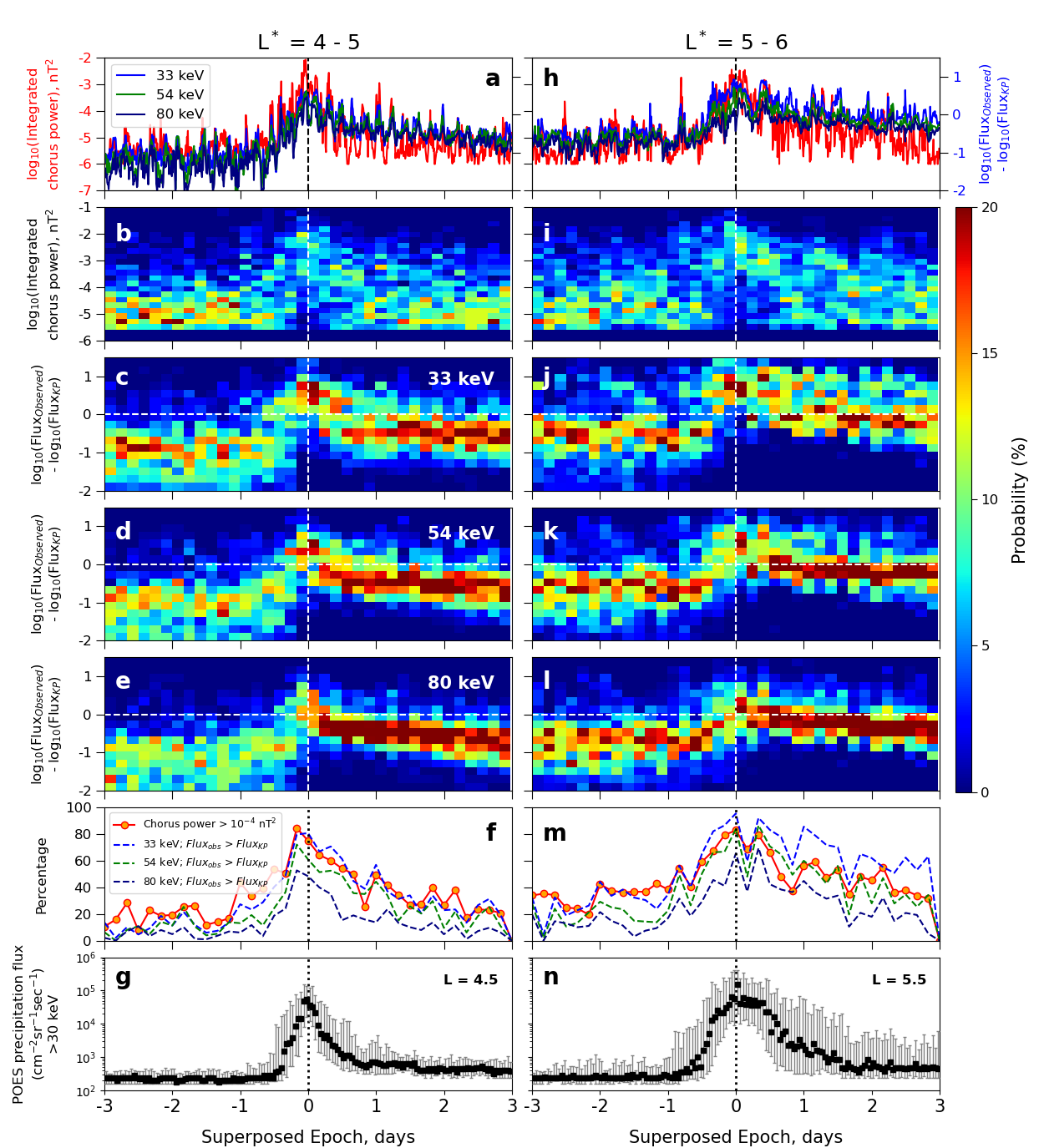
Figure 1: Median (a, h) integrated chorus wave power (nT2; red) and difference of observed and calculated KP limiting flux for 33 keV (blue), 54 keV (green), and 80 keV (navy) electrons; probability distribution function (PDF) of (b, i) integrated chorus wave power and difference of observed and KP limiting flux for (c, j) 33 keV, (d, k) 54 keV and (e, l) 80 keV electrons in logarithmic scale; (f, m) percentage of finding integrated chorus wave power> 10−4 nT2 and observed flux greater than KP limiting flux for 33 keV (blue), 54 keV (green) and 80 keV (navy) electrons within the L∗ range 4–5 (left panel) and 5–6 (right panel); and precipitating flux as observed by POES for > 30 keV electrons at (g) L = 4.5 and (n) L = 5.5 as a function of superposed epoch (in days) between 0 − 12 MLT. In each panel, the vertical dashed line marks the zero epoch, and the horizontal dashed lines in panels (c–e) and (j–l) indicate the observed flux being equal to the KP limiting flux. The colorbar at the right denotes the PDF so that the probability of finding events in each vertical slice adds up to 100%. In panels (g, n), the black scatter plot shows median electron flux and the error bars represent upper and lower quarterlies of the superposed epoch statistics.
Reference: Chakraborty, S., Mann, I.R., Watt, C.E.J., Rae, I.J., Olifer, L., Ozeke, L.G., Sandhu, J.K., Mauk, B.H., and Spence, H. Intense chorus waves are the cause of flux-limiting in the heart of the outer radiation belt. Sci Rep 12, 21717 (2022).https://doi.org/10.1038/s41598-022-26189-9.
Finding the Magnetopause Standoff Distance Using a Soft X-Ray Imager
By Andrey Samsonov (University College London)
The magnetopause standoff distance characterizes global magnetospheric compression and deformation in response to changes in the solar wind dynamic pressure and interplanetary magnetic field. We cannot derive this parameter directly from in situ spacecraft measurements because spacecraft cross the magnetopause rarely and in different regions along the magnetopause surface. However, it will be possible to obtain the time series of the magnetopause standoff distance in the near future using observations by soft X-ray imagers. In two companion papers (see below), we describe methods of finding the standoff distance from X-ray images. Soft X-rays are emitted in the magnetosheath and cusps as a result of charge exchange between heavy solar wind ions and exospheric neutrals. We use the results of MHD simulations to calculate the X-ray emissivity for different solar wind conditions. We simulate an artificial case with constant solar wind conditions and a case with an interplanetary coronal mass ejection (ICME) observed by the Wind spacecraft on 16-17 June 2012. Some MHD models predict relatively high density in the magnetosphere, larger than observed in the data. Correcting this, we develop magnetospheric masking methods to separate the magnetosphere from the magnetosheath and cusps.
We use the SXI_SIM numerical code developed at the University of Leicester to simulate the expected output of the Soft X-ray Imager (SXI) on board the forthcoming Solar wind Magnetosphere Ionosphere Link Explorer (SMILE) mission. Using the MHD results as input conditions, this code calculates the integrated emissivity along the Line-of-Sight (Ix) and SXI counts maps (see Figure 1). We verify the assumption that the maximum of the integrated emissivity is tangent to the magnetopause. Overall, the magnetopause is located close to the maximum Ix gradient or between the maximum Ix gradient and the maximum Ix depending on the method used. But since the angular distance between the maximum Ix gradient and the maximum Ix is relatively small (about 3°), the maximum Ix might be used as an indicator of the outer boundary of a wide magnetopause layer usually obtained in MHD simulations.
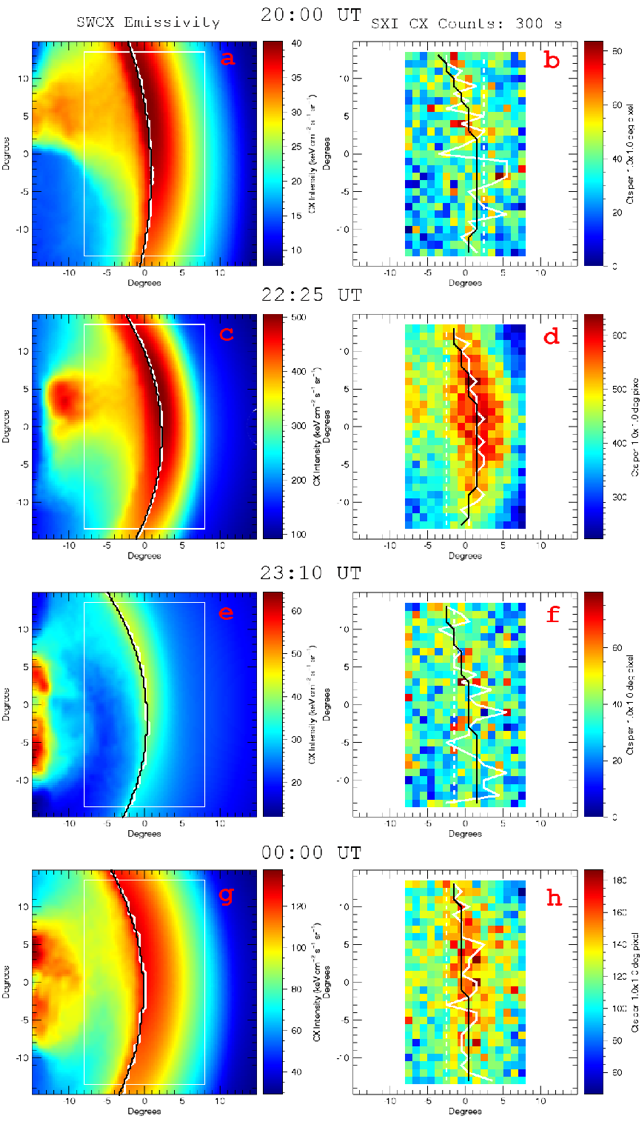
Original articles for further detail:
Samsonov, A., Carter, J. A., Read, A., Sembay, S., Branduardi-Raymont, G., Sibeck, D., & Escoubet, P. (2022). Finding magnetopause standoff distance using a soft X-ray imager: 1. Magnetospheric masking. Journal of Geophysical Research: Space Physics,
127, e2022JA030848. https://doi.org/10.1029/2022JA030848
Samsonov, A., Sembay, S., Read, A., Carter, J. A., Branduardi-Raymont, G., Sibeck, D., & Escoubet, P. (2022). Finding magnetopause standoff distance using a Soft X-ray Imager: 2. Methods to analyze 2-D X-ray images. Journal of Geophysical Research: Space Physics, 127, e2022JA030850. https://doi.org/10.1029/2022JA030850
LOFAR Observations of sub-structure within a Travelling Ionospheric Disturbance at mid-latitude
By Gareth Dorrian (Space Environment & Radio Engineering, University of Birmingham)
Travelling ionospheric disturbances (TID) are ubiquitous wave-like propagations in the Earth’s ionosphere and are the ionospheric counterpart of neutral atmospheric gravity waves (AGW). AGW can be driven by numerous sources from both the terrestrial and space weather domain such as sunrise, auroral sub-storms, volcanic eruptions, or thunderstorms. Terrestrial drivers from the lower atmosphere are coupled to the thermosphere by upwards propagation of AGW (Hines, 1960).
We study the ionosphere using LOFAR observations of trans-ionospheric radio propagation from compact natural radio sources. This is advantageous as, unlike most artificial satellites, natural radio sources are inherently broadband emitters and LOFAR is a broadband receiver with high frequency and time resolution. The behaviour of radio scattering through the ionosphere can thus be observed simultaneously across many frequencies.
Observations using the LOw Frequency ARray (LOFAR: van Haarlem et al., 2013) of trans-ionospheric radio propagation through a TID over the UK were made on 7 January 2019 (Figure 1). In LOFAR data, ionospheric variability manifests as rapid changes in the received signal from the radio source. Using this technique, internal sub-structure within the TID were clearly identified with dominant modes of oscillation on timescales of ~300s. At the observing geometries used these oscillations equated to sub-structure scale sizes of ~20 km. Contemporary GNSS and ionosonde data were used to provide the global parameters of the TID. At the observation frequencies used (25-65 MHz) the Fresnel scale is between 3-4 km; consequently the majority of the scattering features observed were lens-like refractions, rather than diffractive scintillation. Geomagnetic conditions at this time were very quiet, suggesting a terrestrial driver.
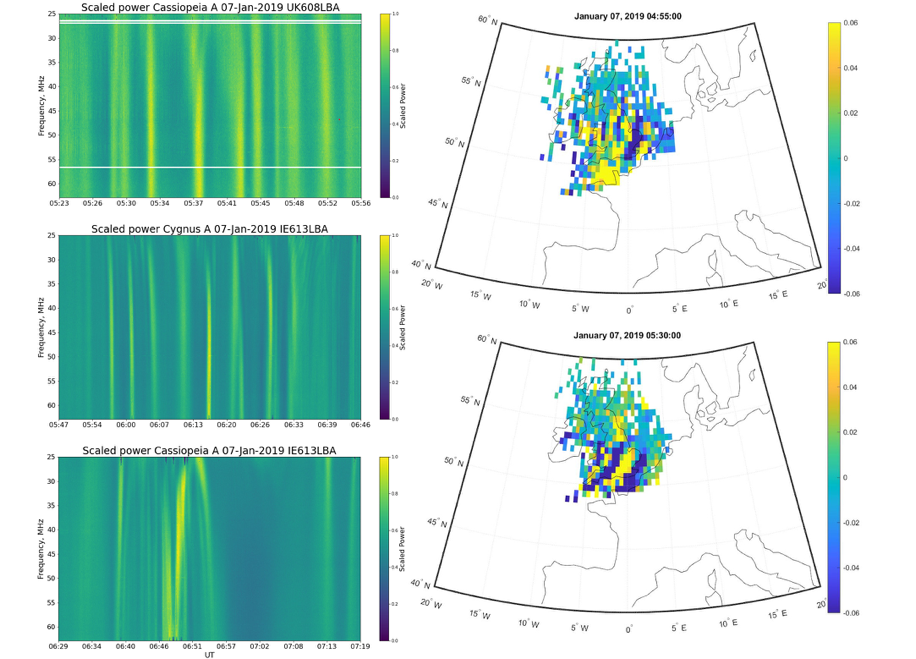
Figure 1: Left panels: LOFAR dynamic spectra from UK and Irish stations showing rapid variations in received signal power across the full observing band, caused by passage of TID internal substructure across raypath. Right panels: GNSS plasma anomaly maps from the observing period with the wave-like form of the TID clearly visible over the UK.
Original article for further details:
Dorrian, G., Fallows, R., Wood, A., Themens, D. R., Boyde, B., Krankowski, A., et al. (2023). LOFAR observations of substructure within a travelling ionospheric disturbance at mid-latitude. Space Weather, 21, e2022SW003198. https://doi.org/10.1029/2022SW003198
References:
van Haarlem, M. P., Wise, M. W., Gunst, A. W., Heald, G., McKean, J. P., Hessels, J. W. T., et al. (2013). LOFAR: Low-frequency-array. Astronomy and Astrophysics, 556, A2. https://doi.org/10.1051/0004-6361/201220873
Hines, C. O. (1960). Internal atmospheric gravity waves at ionospheric heights. Canadian Journal of Physics, 38(11), 1441– 1481. https://doi.org/10.1139/p60-150